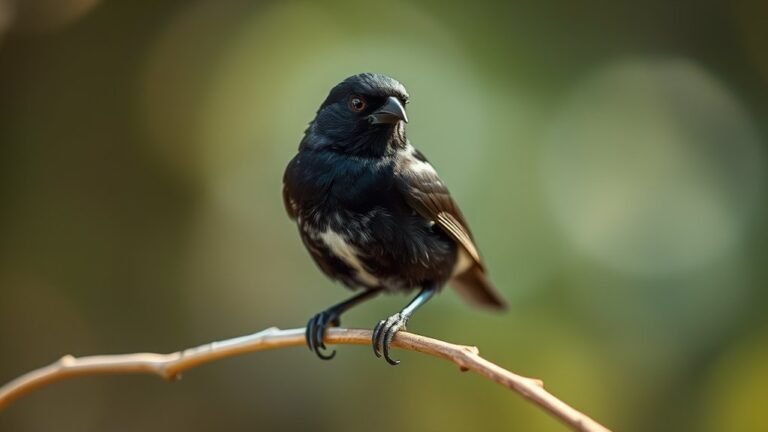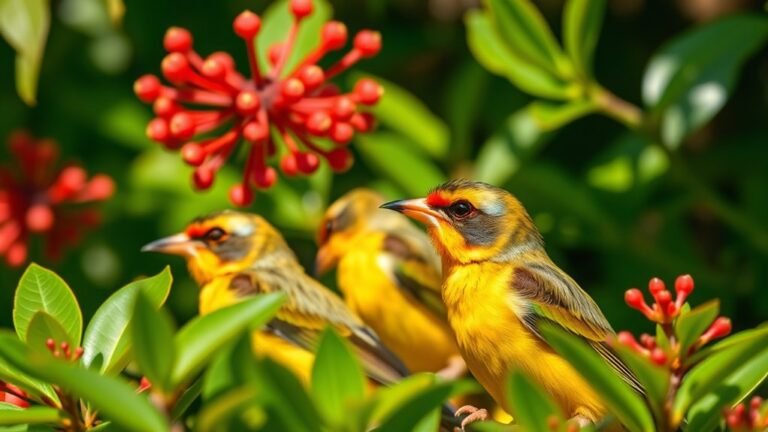Hawks in Illinois: Identification and Conservation Tips
Hawks in Illinois include different species, each with unique feathers and behaviors. By learning to identify these traits, you can spot them in many settings. Knowing their migration habits helps you understand their importance in the environment. Finding good places to watch them can make your experience even better.
You can help protect these amazing birds while enjoying birdwatching. Simple actions like reporting hawk sightings and supporting local conservation efforts can make a difference. Every effort counts in preserving these raptors for future generations. Enjoy your time observing hawks and remember your role in their conservation.
Key Takeaways
To identify hawks in Illinois, look at their feather patterns, wing shapes, and tail lengths. Pay attention to their colors and sizes.
Red-tailed Hawks are common and have rusty-red tails. They can be found in cities and the countryside. Cooper's Hawks prefer wooded areas.
Observe their hunting skills, like soaring or ambushing, to help identify different species.
For the best hawk watching, visit places like Illinois River bluffs, Cache River State Natural Area, and Starved Rock State Park, especially during migration seasons.
Support hawk conservation by joining local wildlife preservation activities and sharing information about their ecological roles. Enjoy watching these amazing birds in their natural habitats!
Overview of Hawk Species in Illinois

Illinois hosts a variety of hawks that enhance its avian ecosystem. These birds adapt to different environments, including fields and forests.
The Red-tailed Hawk soars above urban and rural areas, showcasing its strong adaptability. The Cooper's Hawk prefers wooded regions, where it skillfully hunts smaller birds.
Learning about their nesting and hunting behaviors can deepen your appreciation for these amazing raptors. These species not only represent the natural beauty of Illinois but also play vital roles in local ecosystems, encouraging you to connect with nature in your community.
Key Characteristics for Identifying Hawks
Identifying hawks is a rewarding activity for birdwatchers and nature lovers. To tell these beautiful birds apart, observe their plumage patterns. These patterns can differ significantly between species. Hawks may display colors like browns, blacks, and whites, allowing them to blend in with their environment.
Pay attention also to the size and shape of a hawk's wings and tail, as these features can reveal their identity. Observing how hawks hunt is crucial too. Some hawks soar high while scanning for food, while others prefer to ambush from a perch.
By focusing on plumage patterns and hunting behaviors, you can improve your hawk identification skills. This process will enhance your appreciation for these captivating birds.
Enjoy your birdwatching!
Common Hawk Species Found in Illinois

Illinois is home to various hawk species, attracting birdwatching enthusiasts. One well-known species is the Red-tailed Hawk, easily identified by its rusty-red tail and broad wings. You can see them soaring overhead or sitting on trees, looking for food below.
In contrast, the Cooper's Hawk is more difficult to spot. They prefer woodlands and suburban areas. Cooper's Hawks are medium-sized and have short tails. You may see them darting through trees while chasing smaller birds.
Knowing these hawks improves your birdwatching experience. This knowledge helps you appreciate their behaviors and habitats in Illinois.
Embrace this connection to local wildlife, enhancing your understanding of nature. Enjoy watching these magnificent birds as they go about their lives in diverse landscapes.
Seasonal Migration Patterns of Hawks
As seasons change, hawks in Illinois show clear migration patterns. They migrate due to temperature changes, food supply, and daylight variations.
You can see hawk behavior, like soaring and gliding, as they use thermals to save energy during long flights. By late summer and early fall, many hawks start flying south. In spring, they return to their breeding areas.
Learning about these migration patterns helps you connect with nature and highlights the need for conservation to protect their routes. Watching hawks during migration enhances your appreciation for wildlife in Illinois.
Best Locations for Hawk Watching in Illinois

For the best hawk watching in Illinois, several locations are ideal due to their natural features. The bluffs along the Illinois River provide great views during migration seasons.
The Cache River State Natural Area and Starved Rock State Park are also top spots. These areas attract many hawk species and are popular during autumn and spring.
Visit these locations early in the morning for the best chance to see these impressive birds. By choosing the right spots, you can enjoy nature and support hawk conservation in Illinois.
How to Create a Hawk-Friendly Environment
Creating a hawk-friendly environment benefits both hawks and birdwatchers. To attract hawks, install tall trees or structures for nesting. These serve as essential perches during breeding.
Plant native shrubs to provide shelter and protection for their nests.
Hawks rely on small mammals, birds, and insects for food. By maintaining an ecosystem that supports these creatures, you increase the survival chances of hawks in your area.
Reducing pesticide use will also help protect their food sources.
By landscaping thoughtfully and practicing mindful approaches, you can create a welcoming habitat. This effort will support hawks and enhance your birdwatching experience.
Enjoy watching these magnificent raptors thrive in your environment.
Involvement in Hawk Conservation Efforts
Involvement in hawk conservation efforts is important for the survival of these impressive birds.
You can help by joining local organizations focused on hawk rescue. These groups often need volunteers for tasks like feeding and caring for injured or orphaned hawks.
You can also participate in educational programs that raise awareness about hawks and their habitats. These programs teach the public and inspire community involvement in conservation.
Being part of these initiatives helps you connect with others who care about wildlife.
Your efforts will help protect and appreciate hawks, making a difference for both you and these amazing creatures.
Frequently Asked Questions
What Is the Average Lifespan of Hawks in the Wild?
Hawks in the wild have an average lifespan that ranges from 3 to 15 years. This lifespan can change based on various factors such as the quality of their habitat, the availability of food, and threats from predators. By understanding these factors, you can gain a better understanding of hawk behavior and their survival challenges in nature.
How Do Hawks Communicate With Each Other?
Hawks communicate through sounds and actions. They use calls to mark their territory and define boundaries. These calls help attract mates and warn others about dangers. Each vocalization serves a clear purpose, allowing hawks to share important information with one another. Their communication is essential for survival and maintaining social structures in their environment.
Are Hawks Endangered in Illinois?
Hawks are not considered endangered in Illinois. However, some species may encounter challenges. Conservation efforts are important to keep hawk populations healthy. Protecting their habitats also benefits the local ecosystem. Ensuring these birds thrive supports biodiversity and the environment we enjoy.
What Do Hawks Eat Besides Small Mammals?
Hawks eat a variety of prey besides small mammals. Their diet includes birds, reptiles, and insects. They adapt their eating habits based on what is available. This flexibility in diet highlights their important role in the ecosystem. Understanding what hawks eat helps us appreciate their contribution to nature.
Can Hawks Be Kept as Pets?
You cannot keep hawks as pets due to legal reasons. Caring for hawks requires special permits and specific habitats. Hawks need freedom to thrive. Respecting wildlife helps protect their species and supports healthy ecosystems for future generations.

Kashvi is a passionate bird enthusiast and nature lover who has been fascinated by the world of birds for years. With a keen eye for detail and a love for learning, Kashvi is dedicated to sharing her knowledge and insights with fellow bird enthusiasts on Avian Enthusiasts. Through her engaging and informative articles, Kashvi aims to inspire others to join her in exploring the fascinating world of birds and to promote a deeper appreciation for these incredible creatures.







